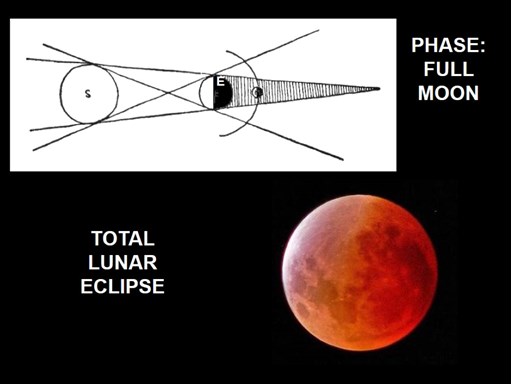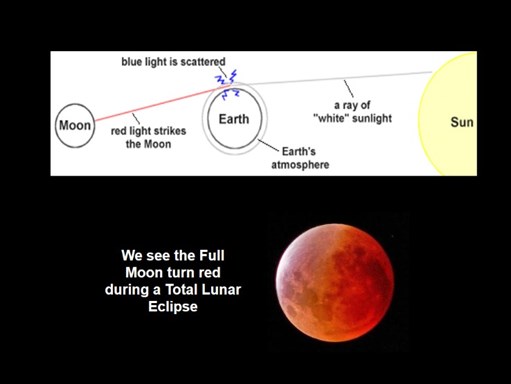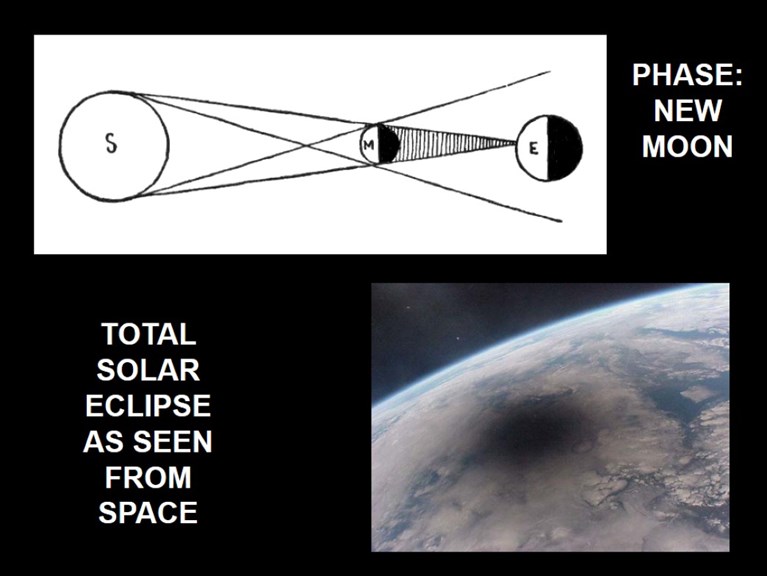Activity: Understanding eclipses for the moon base
Students model lunar and solar eclipse and think about the impact of these on the moon base.
A Total Lunar Eclipse
A Total Lunar Eclipse occurs when the Moon passes behind the Earth so that the Earth blocks the Sun's rays from striking the Moon. This can occur only when the Sun, Earth, and Moon are aligned exactly. Hence, a Total Lunar Eclipse can only happen the night of a Full Moon.
The Total Lunar eclipse from start to finish can take up to about 5.5 hours. The Moon looks dark at first and then looks red for about 1.5 hours when it is in the darkest part of the Earth’s shadow. The reason why it looks red is because white light is made up of the colours of the rainbow and the red part of light is able to bend around the Earth’s atmosphere and reach the Moon whereas the blue/green parts are scattered into space. Anyone living in a place experiencing night time and can see the Full Moon will be able to see the Total Lunar eclipse.
What to do
Demonstrate a total lunar eclipse using the following materials:
- Various size balls (one to represent the Moon and another to represent the Earth)
- Lamp (representing the Sun)
- Dark room
A Total Solar Eclipse
For a Total Solar Eclipse the Moon must pass between the Sun and the Earth and they must line up exactly so that the Moon blocks the light from the Sun. The Moon must be in New Moon phase for a Total Solar Eclipse to occur. How can something as small as the Moon cover something as big as the Sun? Well, it just so happens that the Moon is just far away enough from the Sun (about 400 times the distance between the Earth and the Moon) to be able to cover exactly if it is aligned with it.
It takes approximately 2 hours from start to finish but the Sun is completely covered for only a couple of minutes (on average but can be up to 7.5 minutes).
Only the people in the Moons shadow can see the event or experience it. You need special protective glasses/devices to see the eclipse safely, but not when the Sun is completely blocked out by the Moon.
When the Sun is completely blocked out by the Moon, it darkens and gets cold for the duration of the eclipse.
Why not a Total Lunar eclipse and Total solar eclipse every month?
The reason why we don’t experience a Total Lunar eclipse and Total solar eclipse every month is because the Earth and Moon do not orbit on the same plane. The Moon orbits at an angle of five degrees to the Earth-Sun plane. So most of the time, the exact alignment of the Earth Moon and Sun is not possible except for two times of the year. (Remember we are talking about Total eclipses only).
The opportunity for this alignment usually occurs twice a year about six months apart. They don’t always occur the same time of the year because of the Sun’s influence on the orbit of the Moon. So the times of the year the total eclipses can occur change (on an 18.6 year cycle) but they always occur about 6 months apart.
What to do
1. Demonstrate a total solar eclipse using the following materials:
- Various size balls (one to represent the Moon and another to represent the Earth)
- Lamp (representing the Sun)
- Dark room
2. Find out the difference between a total solar eclipse and a partial solar eclipse.
- Make a video demonstrating both types of eclipses using the same equipment listed in Question 1.
- Show your video to your class mates.
- Ask for constructive feedback on your explanation/video.
- Re-film the video, taking into account the constructive feedback you received.
3. Find out the difference between a total lunar eclipse and a partial lunar eclipse.
- Make a video demonstrating both types of eclipses using the same equipment listed in Question 1.
- Show your video to your class mates.
- Ask for constructive feedback on your explanation/video.
- Re-film the video, taking into account the constructive feedback you received.
4. Find out how often solar eclipses and lunar eclipses occur per year.
Challenge questions
- Discuss how solar and lunar eclipses will affect your moon base and life on the Moon based on what you have learned.
- Discuss how you will resolve any issues you discover. Make allowances for this on your moon base.
Next activity


